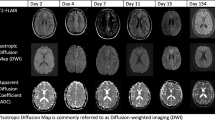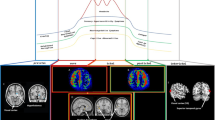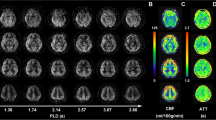Abstract
The pathogenesis of sporadic hemiplegic migraine remains unclear, and perfusion-weighted magnetic resonance imaging (PWI) has been used for characterization of hemodynamic changes in migraine aura. We report a case of sporadic hemiplegic migraine in which magnetic resonance perfusion imaging showed left cerebral hypoperfusion. Dynamic susceptibility contrast (DSC) perfusion maps showed hypoperfusion with posterior predominance in the left cerebral hemisphere. Findings with arterial spin labeling (ASL) perfusion correlated well with DSC perfusion findings.
Conclusion: With unique advantages compared with DSC PWI, ASL has significant potential in the evaluation of the patients with sporadic hemiplegic migraine.
What is Known: • Sporadic hemiplegic migraine is a rare variety of migraine defined by migraine attacks, which include the presence of motor weakness/hemiparesis during the aura phase and where no first- or second-degree relative (parent, sibling, or child) has identical attacks. |
What is New: • Reports on imaging abnormalities described in sporadic hemiplegic migraine are sparse. • To our knowledge, this is the first report to describe arterial spin labeling (ASL) perfusion abnormalities in patients with sporadic hemiplegic migraine, as compared with dynamic susceptibility contrast perfusion-weighted magnetic resonance imaging (PWI). |

Similar content being viewed by others
Abbreviations
- ASL:
-
Arterial spin labeling
- CBF:
-
Cerebral blood flow
- DSC:
-
Dynamic susceptibility contrast
- PWI:
-
Perfusion-weighted magnetic resonance imaging
- Tmax:
-
Time-to max
References
Aurora SK, Welch KM (2000) Migraine: imaging the aura. Curr Opin Neurol 13(3):273–276
Förster A, Wenz H, Kerl HU, Brockmann MA, Groden C (2014) Perfusion patterns in migraine with aura. Cephalalgia 34(11):870–876
Hadjikhani N, Sanchez Del Rio M, Wu O, Schwartz D, Bakker D, Fischl B, Kwong KK, Cutrer FM, Rosen BR, Tootell RB, Sorensen AG, Moskowitz MA (2001) Mechanisms of migraine aura revealed by functional MRI in human visual cortex. Proc Natl Acad Sci U S A 98(8):4687–4692
Headache Classification Committee of the International Headache Society (IHS) (2013) The international classification of headache disorders, 3rd edition (beta version). Cephalalgia 33(9):629–808
Hsu DA, Stafstrom CE, Rowley HA, Kiff JE, Dulli DA (2008) Hemiplegic migraine: hyperperfusion and abortive therapy with intravenous verapamil. Brain Dev 30(1):86–90
Huang YC, Liu HL, Lee JD, Yang JT, Weng HH, Lee M, Yeh MY, Tsai YH (2013) Comparison of arterial spin labeling and dynamic susceptibility contrast perfusion MRI in patients with acute stroke. PLoS One 8(7):e69085
Jacob A, Mahavish K, Bowden A, Smith ET, Enevoldson P, White RP (2006) Imaging abnormalities in sporadic hemiplegic migraine on conventional MRI, diffusion and perfusion MRI and MRS. Cephalalgia 26(8):1004–1009
Lindahl AJ, Allder S, Jefferson D, Allder S, Moody A, Martel A (2002) Prolonged hemiplegic migraine associated with unilateral hyperperfusion on perfusion weighted magnetic resonance imaging. J Neurol Neurosurg Psychiatry 73(2):202–203
Oberndorfer S, Wöber C, Nasel C, Asenbaum S, Lahrmann H, Fueger B, Grisold W (2004) Familial hemiplegic migraine: follow- up findings of diffusion-weighted magnetic resonance imaging (MRI), perfusion-MRI and [99mTc] HMPAO-SPECT in a patient with prolonged hemiplegic aura. Cephalalgia 24(7):533–539
Thomsen LL, Olesen J (2004) Sporadic hemiplegic migraine. Cephalalgia 24(12):1016–1023
Conflict of interest
The authors declare that they have no (financial) conflict of interest.
Ethical approval
The case report was approved by the local ethical committee.
Informed consent
The requirement of informed consent was waived for this retrospective study.
Source of support
No sources of financial and material support to be declared.
Author’s contributions
SH Kim and MJ Kang contributed in the conception, analysis, and interpretation of the study. SS Choi drafted the manuscript for important intellectual content.
Author information
Authors and Affiliations
Corresponding author
Additional information
Communicated by Mario Bianchetti
Rights and permissions
About this article
Cite this article
Kim, S., Kang, M. & Choi, S. A case report of sporadic hemiplegic migraine associated cerebral hypoperfusion: comparison of arterial spin labeling and dynamic susceptibility contrast perfusion MR imaging. Eur J Pediatr 175, 295–298 (2016). https://doi.org/10.1007/s00431-015-2609-2
Received:
Revised:
Accepted:
Published:
Issue Date:
DOI: https://doi.org/10.1007/s00431-015-2609-2




